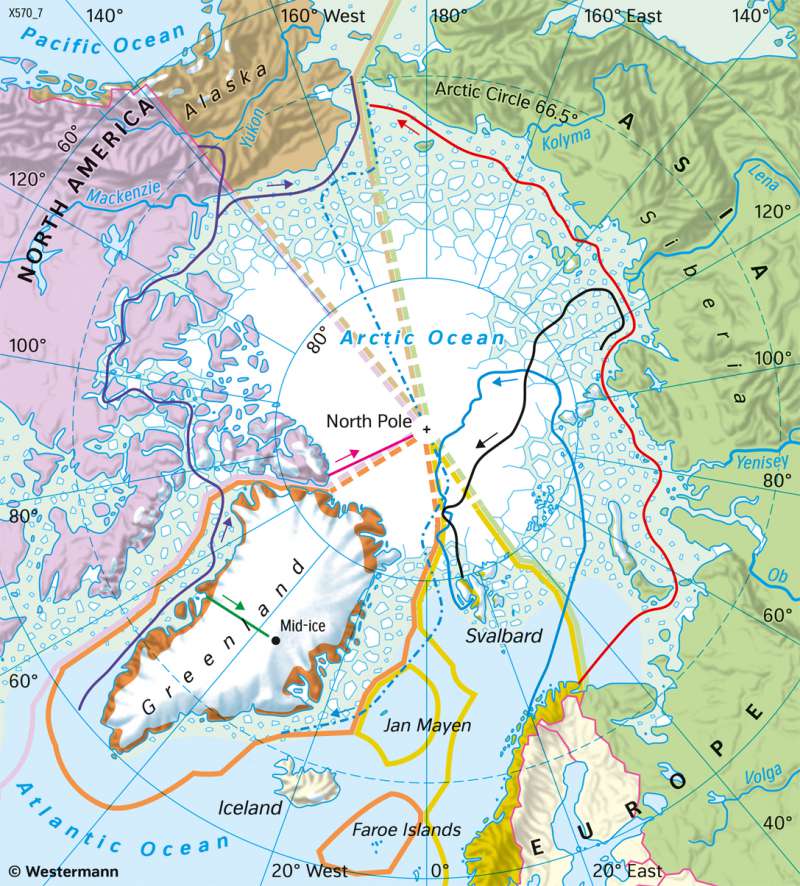Arctic - Discoveries and claims
Human activities and environmental change
978-3-14-100890-6 | Page 201 | Ill. 4

Overview
The first Arctic voyages were undertaken by the Vikings, who were looking for new places to settle. With the beginning of the modern era, colonial interests were in focus. From 1734 to 1743, the Dane Vitus Bering undertook the "Great Northern Expedition" to the Siberian coast, the Bering Strait, Alaska and the Alëutes on behalf of the Tsar. From the 19th century onwards, the expeditions served primarily to find a passage between Europe and Asia.
The expeditions of early polar explorers
For the first time, the Swede Otto Nordenskjöld succeeded in crossing the Northeast Passage along the coast of North Asia to the Bering Sea in 1878/1879. Between 1893 and 1896, the Norwegian Fridtjof Nansen tried to get close to the North Pole with a ship trapped in the ice and following its natural drift. With skis and sledges, he came closer to the North Pole than any man before, after leaving the expedition ship in March 1895. From 1903 to 1906, the Norwegian Roald Amundsen conquered the Northwest Passage. In 1908, Frederick Cook claimed to have reached the North Pole, but many doubted it. The Peary expedition of 1909 at least came close to it. From 1921 to 1924, the Greenlandic-Danish polar explorer Knud Rasmussen crossed the American Arctic from Greenland to Alaska for the first time.
A first German Arctic expedition from 1868 to 1870 reached East Greenland and Spitsbergen under Captain Koldewey. The German Erich von Drygalski wintered at the edge of the inland ice in West Greenland from the end of 1892. These approaches were then continued by the geophysicist Alfred Wegener with his great Greenland expedition from 1929 to 1931.
In 1959, the "Nautilus", a US submarine with nuclear propulsion, passed under the North Pole. In 1977, the nuclear-powered Soviet icebreaker Arktika was the first ship to reach the North Pole.
Sovereignty claims
Large deposits of oil, natural gas, diamonds, precious and non-ferrous metal ores are believed to exist at the bottom of the Arctic Ocean, giving rise to national rivalries. With regard to sovereignty claims in the Arctic, Russia (or previously the Soviet Union), Canada and the USA originally advocated the sector principle with territorial claims up to the North Pole.
But under international law, the United Nations Convention on the Law of the Sea applies in the Arctic. All riparian states have signed this, except the USA, which nevertheless adheres to it. Within the 200-nautical-mile economic zone, the respective coastal state has the exclusive right of use (for example, fishing, mining). Outside this zone, the extent of the continental shelf under the sea determines the right of use (for example, for raw material extraction). Its course is currently disputed, which explains the existence of undefined boundaries of the territories in the Arctic.
As members of the Arctic Council, the five riparian states, Denmark (also for Greenland and Faeroe), Canada, Norway, Russia, and the USA, are also bound by the principle of cooperating in the exploitation of raw materials. Finland, Iceland and Sweden also belong to the body, which was founded in 1996. In addition, six indigenous peoples' organisations have a say as permanent participants. Other states and NGOs can participate as observers. The Arctic Council sees itself primarily as a forum for reconciling interests (raw material extraction) and joint scientific research in the Arctic.




